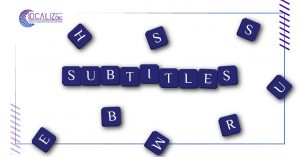
Today, communication through audiovisual media is stronger than ever. To keep up with the latest work opportunities, many translators have chosen to break into this yet-very-young translation field, without being truly prepared.
For those of you who are curious about the process that makes it possible for us to understand and appreciate a foreign movie effortlessly, without even realizing that we are reading lines in the meanwhile, here is a brief introduction to what subtitling means and how it is done.
Subtitling is a type of Audio-visual translation (AVT), characterized by its own techniques, rules, and restrictions. Its most peculiar restriction is the one time and space, which strongly distinguishes subtitling from other types of translation, even within the AVT sector.
A subtitle is made of two lines, containing a maximum of 70 characters – therefore a maximum of 35 characters per line (character meant as any letter, symbol, or space).
For what concerns time, the duration of a subtitle ranges from one to six seconds. Moreover, it must be considered that our average reading speed is about three words per second. This means that, even though the time span of one subtitle might allow it to contain many words, it is still advisable to summarize the content as much as possible and keep the lines short, otherwise the spectator will not be able to read it all.
Many films and TV shows benefit from subtitling, but only when it’s done right.
That’s why there are agencies that specialize in subtitling and related services — since this is a detail-oriented task, not just anyone can do it successfully.
In order to give audiences an enjoyable (and accurate!) viewing experience, subtitling experts pay attention to the little things that result in effective subtitles.
Here are some tips to take care of when subtitle
1- The Appearance of the Words Matters
For subtitling to work, the words on the screen have to be legible to the audience. This is not always an easy detail to figure out, since scenes change color so often.
2- The Importance of Proper Line Length
Subtitling experts must take into account how long each line on the screen can be. When there is a lot of dialogue, it can be difficult to determine the proper line length, and how soon the next one should appear.
3- Timing Is Everything
A final consideration is the timing of the words on the screen. Not surprisingly, bad timing can ruin a program for the audience.
When the subtitles appear on the screen too early, viewers may be confused until they get to the appropriate scene.
Why should you add subtitles to your videos
- A great way to learn new languages
- Helps non-native speakers consume the content in their language
- Essential for deaf or hard of hearing to consume content
- Improves SEO
- Helps in consuming incomprehensive videos
- Makes it possible to consume video content on mute
Benefits of Subtitles
Subtitles are usually meant for any audience which doesn’t speak the same language as the audio in a visual setting. It involves two steps – transcribing and translating. A subtitling expert would first transcribe the audio (in the source language) and then translate the text into the target language. Subtitling experts must be native speakers of the target language and have fluency in the source language. Like captions, subtitles are written in the form of time-coded sections.
If you have any questions about the topic, we will be happy to continue the discussion.








